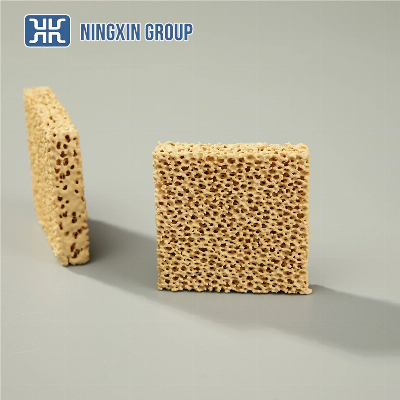High Performance SIC Al2O3 ZrO2 Ceramic Foam Filters for molten
metal filtrationModel Name: NINGXIN-CFF-Z1Application: For the
filtration of molten Iron,copper, aluminum and steel alloyCeramic
foam filters offer a simple, reliable and costeffective method to
remove inclusions. Filtering with CFF is a supplement to metal
treatment within the furnace, such as fluxing and degassing or
inline filtration. Ceramic foam filters have an open pore
reticulated structure with very high porosity and surface area to
trap inclusions. The open foam structures are compose of ceramic
material, such as alumina, mullite or silica. Alumina is the most
common filter material. Ceramic foam filters operate in a deep bed
filtration mode where inclusions smaller than the pore openings are
retained throughout the cross-section of the filter. CFFs typically
are a polyurethane foam coated with a ceramic slurry then dried and
fired. During firing, the polyurethane foam dissipates leaving
behind a porous ceramic structure. The ceramic can be a
phosphate-bonded alumina and pore sizes and thicknesses can vary.
Main materialSilicon carbide (SIC), Alumina, ZirconiaWorking
Temperature1100ºC - 1700ºCColorGrey/white/yellowHole
density10/15/20/25/30PPI (PPI=pores per
inch)Porosity(%)80‐90Compressive Strength(MPa) ≥1.0 (Room
temperature)Bulk Density(g/cm3)0.35‐0.55/ 0.4-0.5/0.8-1.1Thermal
shock resistance≥2times/1100ºC‐Room temperature Product
DescriptionCeramic foam filters are mainly designed to improve the
quality of metal castings. The filter can effectively remove
non-metallic inclusions including slag and dross from the molten
metal stream. Additionally, they aid in reducing turbulence in the
gating system. Ceramic foam filter's outstanding thermal shock
resistance and high strength properties were developed for superior
performance in extreme iron, steel or aluminum and copper based
alloy foundry applications.Inclusion removal efficiency in molten
steel filtrationInclusion removal efficiency was observed to be
strongly dependent on the initial inclusion concentration. Solid
alumina inclusions are found to be captured within the filter at
the metal-filter macropore interface. The concentration of the
captured solid inclusions decreased exponentially from the entry to
exit side of the filter, following first order capture kinetics.
Liquid inclusions were captured within the micropores of the
ceramic web structure and at the metal-filter macropore interface.
The captured liquid inclusion concentration within filter
micropores also followed an exponential trend for lower inclusion
loading, whereas it became constant for higher inclusion loading
due to complete saturation of the ceramic web micropores. Upon
filter micropore saturation, continuous liquid inclusion films
developed at the metal-filter macropore interface, increasing the
possibility for the release of large liquid inclusions from the
filter.Company Profile /* March 10, 2023 17:59:20
*/!function(){function s(e,r){var
a,o={};try{e&&e.split(",").forEach(function(e,t){e&&(a=e.match(/(.*?):(.*)$/))&&1
Related products about Wind Mill Furnace Filtration Zro2 Foundry Filter 90X25mm Stainless Steel Molten Metal
-
 Waste Tyre Plastic Recycling Machinery Machine Tire Crusher Production Line Rubber Crumb Grinding Machine Equipment Tire Shredder
Waste Tyre Plastic Recycling Machinery Machine Tire Crusher Production Line Rubber Crumb Grinding Machine Equipment Tire Shredder
-
 Stretch Plastic Blowing Pet Bottle Making Blow Molding Machine Bottles Stretch Automatic Pet Bottle Blowing Machine
Stretch Plastic Blowing Pet Bottle Making Blow Molding Machine Bottles Stretch Automatic Pet Bottle Blowing Machine
-
 Waste Plastic Pet Bottle, Water Bottle Flake, PP/HDPE/LDPE PE Film Jumbo Woven Bags Plastic Crusher Machine, Plastic Crushing Washing Recycling Machine
Waste Plastic Pet Bottle, Water Bottle Flake, PP/HDPE/LDPE PE Film Jumbo Woven Bags Plastic Crusher Machine, Plastic Crushing Washing Recycling Machine
-
 Type 2 Wall-Mounted Electric Car Charging Station 7kw /11 Kwelectric Vehicle Charging Station Home Wallbox AC EV Charger Single Phase or 3three Phase
Type 2 Wall-Mounted Electric Car Charging Station 7kw /11 Kwelectric Vehicle Charging Station Home Wallbox AC EV Charger Single Phase or 3three Phase
-
 G-View G12W Wholesale Auto Car LED Headlight Bulb High Power H13 H11 9005 H7 H4 Car LED Headlights LED Car Lights
G-View G12W Wholesale Auto Car LED Headlight Bulb High Power H13 H11 9005 H7 H4 Car LED Headlights LED Car Lights
-
 New Design Porcelain Round Plates Dinner Set for Wedding and Banquet
New Design Porcelain Round Plates Dinner Set for Wedding and Banquet
-
 China 2023 New Design Super Soft 100% Polyester Microfiber Knitted Oversized Decoration Hoodie Blanket
China 2023 New Design Super Soft 100% Polyester Microfiber Knitted Oversized Decoration Hoodie Blanket
-
 Handmade Art Creative Materials Thickened White Paper Cup DIY Disposable Handmade Colored Paper Cup
Handmade Art Creative Materials Thickened White Paper Cup DIY Disposable Handmade Colored Paper Cup



